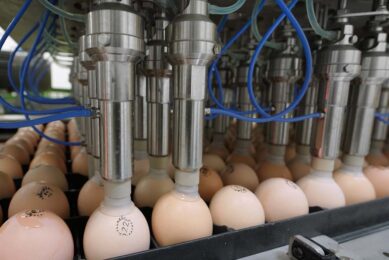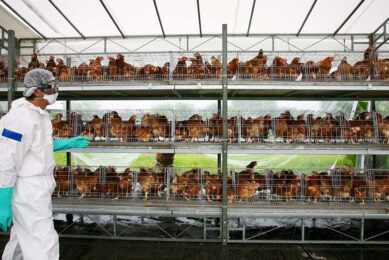The double benefits of combined enzymes use

Any means of improving feed utilisation by animals should result in benefits. In this regard, enzymes, such as xylanase and protease are key additives to be considered in animal nutrition.
As the cost of feed generally represents between 60-70% of the total cost of animal production, feed efficiency is a major parameter to consider when optimising the cost of production. In addition to other levels of action, such as genetics, management or feed processing, optimisation of feeds is one of the key factors for improving feed efficiency – the ability of the animals to utilise feed nutrients for growth, and as such, meat deposit. The use of enzymes increases feed ingredient digestibility, therefore contributing to enhanced weight gain and feed conversion. Proteases will increase crude protein (CP), peptides and amino acid (AA) digestibility, and Xylanase, which degrades arabinoxylans (AX) will allow an increase in energy digestibility and reduce problems linked with viscosity, especially in straw cereals rich diets.
Selecting the right enzymes
Enzyme usage and the subsequent reduced need for energy and protein rich ingredients, results directly in cost savings. Nevertheless, if not controlled, this reduction can adversely affect feed efficiency. Therefore, the selection and use of enzymes should carefully be considered.
Enzymes are substrate specific and a basic knowledge of the substrate chemical structure is essential to select the proper enzymes for the targeted effect. Matching an enzyme activity with a substrate does not guarantee efficacy. Each enzyme, even within the same family, depending on its source, structure and affinity, is unique and can also play a role in other physiological parameters as shown on gastrointestinal tract integrity or generation of prebiotics, for instance. These are additional factors that require attention in order to get the most out of those additives in terms of feed efficiency improvement.
Proteases
Proteases are naturally produced and present in the gastrointestinal tract of animals. Therefore, selected exogenous proteases in animal nutrition should play a more diverse role than endogenous ones. They should complement the activity of natural proteolytic enzymes with, for instance, resistance to anti-nutritive factors and a wider hydrolysation potential of feed proteins. In poultry and in swine too, numerous trials under various experimental and field conditions demonstrate the efficacy of protease to improve performance or to reduce feed cost while maintaining performance, depending on the nutritional level of programs. The use of a protease enzyme offers an opportunity for animal nutritionists to control and lower the level of dietary CP.
A recent trial performed in Brazil illustrates the consequence of nutrient reduction in the formula and subsequent advantages of protease use in order to improve performance and feed efficiency. 392 male broiler chickens distributed into 4 treatments with 7 replicates/treatment were fed ad libitum a four-phase feeding program for 42 days. 2 diets were used:
- a standard diet based on nutritional recommendations of the Brazilian Tables for Poultry and Swine and
- a low density diet, with 6% reduction CP and digestible lysine (ratio of other essential AA to lysine was kept the same as in standard diet).
The 2 diets were either supplemented or not with a specific protease. By reducing diet CP level, poultry producers could save on feed cost, reduce nitrogen excretion in the environment, and minimise the risk of enteric infections. However, this reduction lead to a higher feed conversion. Supplementation with specific protease, as shown in Figure 1, allowed greater performance and allowed to take advantage of feed cost reduction without compromising on performance losses.
Figure 1 – Body weight and feed conversion ratio (0-42 days).

Xylanases
The use of xylanases in straw cereal-based feeds is widely recognised to alleviate the negative effects linked to soluble AX by reducing the associated viscosity of digestive contents. However, if soluble AX are a concern in straw cereal based diets, the insoluble fraction of AX, which alters the availability of nutrients, also holds the most important share in the majority of ingredients. However, all xylanases are not equal in their ability to act both on the soluble and insoluble part of AX. Therefore, the choice of a xylanase acting on all AX is crucial to optimise energy release and its versatility in front of ingredients choice. Xylanases of bacterial origin possess specific properties which allow them to go further in their action on raw materials by taking full advantage in degradation of soluble, but also insoluble fractions of AX, hence explaining the efficacy of this specific type of xylanase on other cereals such as corn or sorghum, which are raw materials that hold a significant interest in different types of feed formulas. Effectively, 96% of the corn AX are insoluble and bacterial origin xylanase have shown up to four times greater activity on insoluble AX than xylanases of fungal origin. Selection of a broad spectrum xylanase, active on total AX, gives nutritionists greater flexibility in regards to formulation changes, allowing use and energy valorisation regardless of the cereals of interest (corn, sorghum, wheat, etc.).
A trial performed in the US in broilers chicken distributed in pens (seven pens of 60 birds per treatment) fed pelleted feeds showed that a specific xylanase allowed recovery of energy in a corn-soybean meal based diet reduced by -100 kcal ME/kg (Figure 2). Thanks to its intrinsic characteristics, this xylanase from bacterial origin makes it then possible to value the soluble and insoluble AX of various raw materials, as well as forage cereals such as wheat and corn.
Figure 2 – Body weight and feed conversion ratio (0-49d) of animals fed a normal, a reduced and a reduced diet supplemented with a xylanase from bacterial origin.

Finding the perfect match
As protease and xylanase have different substrates, those enzymes represent a perfect match to get the most out of the potential of raw materials combining both CP and AA and energy valorisation. Taking advantage of bacterial origin xylanase and specific protease, a trial performed in the US on corn-soybean meal based diet fed to males broilers until 42 days of age prove the positive combination of single specialised enzymes as illustrated by the EPEF factor recovery (Figure 3).
Figure 3 – European Production Efficiency factor (0-42d) of animals fed a reduced (-80 kcal/kg ME and -5% CP/AA) and the reduced diet (RD) supplemented with either a xylanase from bacterial origin, a specific protease or their combination.

In conclusion, feed efficiency improvement with cost saving and performance maintenance is possible through use of specialty enzymes alone but also in combination. Enzymes, and particularly proteases or xylanase are all unique and different. A precise review of their origin, proven characteristics and advantages is a necessary step in order to get the most out of them. A combination of well characterised xylanase from bacterial origin and specific protease has proven to be a strong guarantee for the best synergy to unlock the full potential of diversified raw materials.
 Beheer
Beheer











 WP Admin
WP Admin  Bewerk bericht
Bewerk bericht